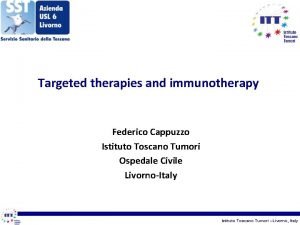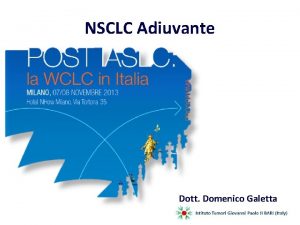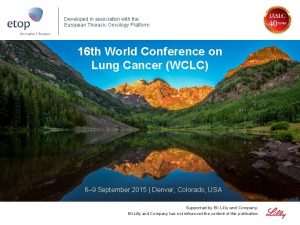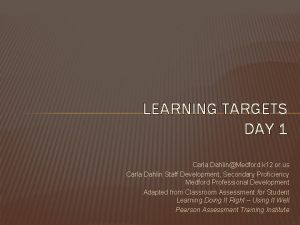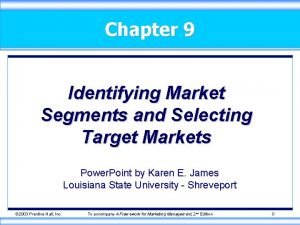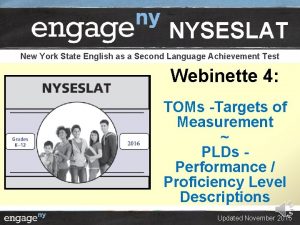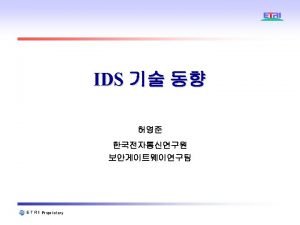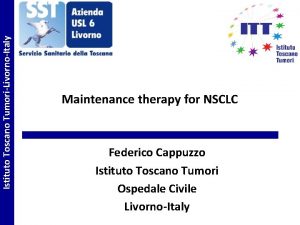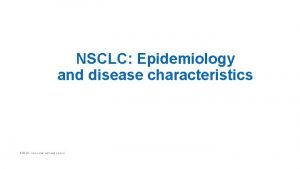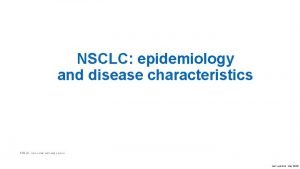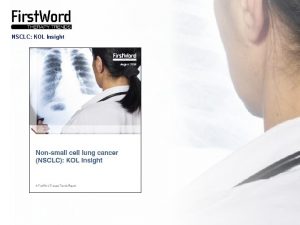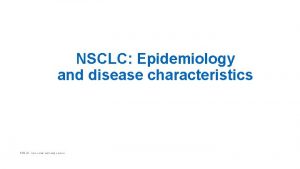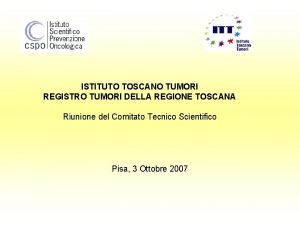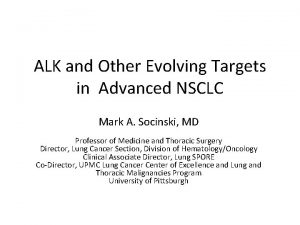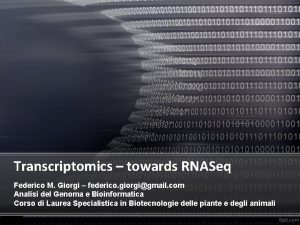New targets in NSCLC Federico Cappuzzo Istituto Toscano
































- Slides: 32

New targets in NSCLC Federico Cappuzzo Istituto Toscano Tumori Ospedale Civile Livorno-Italy Istituto Toscano Tumori –Livorno, Italy

Molecular events in lung cancer Adenocarcinoma Squamous-cell carcinoma EGFR resistance mutations 0. 8% HER 2 0. 9% EGFR 9. 5% Unknown 53. 8% KRAS 27% ALK 3. 7% Barlesi F, ASCO 2013 BRAF 1. 7% PI 3 K 2. 6% Paik PK et al, ASCO 2012 Istituto Toscano Tumori – Livorno, Italy

ROS 1 Translocations in NSCLC Patients with ROS 1 rearrangements share many features in common with ALKpositive patients (adenocarcinoma histology, younger age at diagnosis, never or light smokers) Mutually exclusive with EGFR, HER 2, KRAS, BRAF mutations and with ALK or translocation Prognostic role is not defined SDC 4 exon 2 ROS 1 exon 32 ROS 1 exon 34 Istituto Toscano Tumori – Livorno, Italy

ROS 1 fusion partners in NSCLC Stumpfova and Janne PA, CCR 2013 Istituto Toscano Tumori – Livorno, Italy

Crizotinib: selective inhibitor of ALK, MET and ROS Upstate 102 kinase panel Cellular selectivity on 10 of 13 relevant hits 13 ‘hits’ <100 X selective for Met Kinase Met 8 – ALK 40– 60 5– 8 X ROS 55 7 X RON 80 10 X 294 34 X 322 37 X Tie 2 448 52 X Abl 1, 159 166 X IRK 2, 887 334 X Lck 2, 741 283 X Sky >10, 000 >1000 X VEGFR 2 >10, 000 >1000 X PDGFRβ >10, 000 >1000 X Axl *Measured using ELISA capture method IC 50 (n. M) Selectivity mean* ratio High probability of ALK, MET and ROS inhibition at clinically relevant doses Bang Y, et al. ASCO 2010 Istituto Toscano Tumori – Livorno, Italy

Activity of crizotinib in ROS 1+ NSCLC ORR 72%; DCR 90% Shaw AT, et al. NEJM 2014 Istituto Toscano Tumori – Livorno, Italy

Median DOR of Crizotinib in ROS 1+ NSCLC Median DOR 17. 6 mos (95%CI, 14. 5 – NR) Shaw AT, et al. NEJM 2014 Istituto Toscano Tumori – Livorno, Italy

Crizotinib in ROS 1+ NSCLC: PFS Median PFS: 19. 2 months Shaw A et al, NEJM 2014 Istituto Toscano Tumori – Livorno, Italy

Acquired resistance to crizotinib in ROS 1 NSCLC Awad MM, et al. NEJM 2013 Istituto Toscano Tumori – Livorno, Italy

Second generation ROS 1 inhibitors Istituto Toscano Tumori – Livorno, Italy

Crizotinib in MET amplified or ROS 1 translocated NSCLC: The METROS trial Istituto Toscano Tumori – Livorno, Italy

Clinical characteristics of MET amplified NSCLC Characteristic N % Total amplified (ratio ≥ 2. 2) 16 100 Squamous 5 31. 2 Non-squamous 11 68. 8 Never smokers 0 0 Current/former 15 93. 7 Smoking unknown 1 6. 3 Cappuzzo F et al. , J Clin Oncol 2009 Istituto Toscano Tumori – Livorno, Italy

1, 0 , 8 ≥ 4 - <5 copies/cell , 6 <2 copies/cell ≥ 3 - <4 copies/cell , 4 ≥ 2 - <3 copies/cell ≥ 6 copies/cell ≥ 5 - <6 copies/cell , 2 0, 0 CUMULATIVE SURVIVAL Survival of Resected NSCLC According to MET Copy Number p=0. 0045 , 6 MET <5 copies/cell(N=383) , 4 MET ≥ 5 copies/cell (N=48) , 2 Median survival: MET FISH-: 47. 5 months MET FISH+: 25. 8 months 0, 0 0 20 40 60 MONTHS 80 100 0 20 40 60 80 100 120 MONTHS Cappuzzo et al. , JCO 2009 Istituto Toscano Tumori – Livorno, Italy

High levels of MET amplification drive resistance to EGFR-TKIs Gefitinib Resistant MET amplification in HCC 827 GR 6 Ratio MET/centromere >5 Gefitinib Sensitive NO MET amplification in HCC 827 Ratio MET/centromere <2 Modified from Cappuzzo F, et al. Ann Oncol 2008 Istituto Toscano Tumori – Livorno, Italy

Sensitivity to anti-Met agents only in presence of high levels of MET amplification Smolen GA et al. , PNAS 2006, Tanizaki J et al. , JTO 2011 Garcia L, University of Colorado, personal communication Istituto Toscano Tumori – Livorno, Italy

Tumor Shrinkage Seen in Intermediate and High MET Cohorts Best percent change from baseline in target tumor lesionsa by patient % Change From Baseline 100 Low MET n=2 Intermediate MET n=6 High MET n=6 100 80 80 80 60 60 60 40 40 40 20 20 20 0 – 20 – 40 – 60 – 80 – 100 c – 40 c Disease progression Stable disease Partial responseb Complete responseb Threshold for partial response – 60 a. Confirmed objective responses. on investigator assessment. c. Two patients in the intermediate MET group had an unconfirmed PR that was not confirmed in a second assessment. b. Based Garcia L, University of Colorado, personal communication Istituto Toscano Tumori – Livorno, Italy

RET rearrangements in lung adenocarcinoma • 11, 294, 741 -bp pericentric inversion on chromosome 10 generating a new gene fusion joining exons 1 -15 of KIF 5 B to exons 12 -20 of RET • Mutually exclusive with EGFR, HER 2, KRAS, BRAF mutations and with ALK or ROS 1 translocation • Exclusively identified in moderately to poorly differentiated adenocarcinomas with solid predominant subtype, younger age never or light smokers and with a particular pattern of metastatic spread (lymph nodes) Istituto Toscano Tumori – Livorno, Italy

RET translocation and sensitivity to anti-RET drugs Lipson et al. Nature Med. 2012 Istituto Toscano Tumori – Livorno, Italy

RET FISH+ve NSCLC succesfully treated with vandetanib • 58 y-o man, past smoker (5 pck/yr) • ADC, stage IV for supraclavicular, mediastinal, retroperitoneal and inguinal nodes abdominal, • Pre-treated with standard carboplatin-pemetrexed for 2 cycles with evidence of progression • Second-line* Vandetanib 300 mg daily * Patient unsuitable for standard chemotherapy due to recent myocardial infarction Gautschi O, J Thor Oncol 2013 Istituto Toscano Tumori – Livorno, Italy

Activity of cabozantinib in RET + NSCLC Drilon et al, Cancer Discov 2013 Istituto Toscano Tumori – Livorno, Italy

HER 2 dysregulation in lung cancer Overexpression <10% Amplification <10% Mutation <3% Istituto Toscano Tumori – Livorno, Italy

HER 2 amplification is not prognostic in resected NSCLC Cappuzzo et al. , JTO 2012 Istituto Toscano Tumori – Livorno, Italy

High levels of HER 2 amplification are responsible for acquired resistance to EGFRTKIs in absence of T 790 M Takezawa et al. , Cancer Discovery 2012 Istituto Toscano Tumori – Livorno, Italy

High levels of HER 2 amplification are responsible for acquired resistance to cetuximab in colorectal cancer Yonesaka et al Science Transl Med 2011 Istituto Toscano Tumori – Livorno, Italy

HER 2 mutation exon 19 exon 20 exon 21 YVMA 776 -779 ins GSP 781 -783 ins E A Y V M A G V G S P Y V S R L 770 I A K 785 831 G 776 V, Cins Istituto Toscano Tumori – Livorno, Italy

HER 2 Mutations in NSCLC Reference N Race % Never Smoker (%) Female (%) Sasaki 95 Japan 1. 0 2. 7 3. 3 Marchetti 403 Caucasian 2. 2 3. 1 4. 1 Shigematsu 671 All 1. 6 3. 2 3. 6 Stephens 120 Caucasian 4. 0 - - Arcila 560 All 5. 0* 5. 0 2. 0 * In EGFR and KRAS wild-type population Istituto Toscano Tumori – Livorno, Italy

Trastuzumab efficacy in pretreatred NSCLC patients harboring HER 2 mutation Patient # Therapy Best Response 1 Vinorelbine-trastuzumab Partial response 2 Carboplatin-paclitaxel-trastuzumab Stable disease 3 Docetaxel-masatinib Progression 4 Vinorelbine-trastuzumab Partial response 5 Carboplatin-paclitaxel-trastuzumab Partial response 6 Vinorelbine-trastuzumab Partial response 7 Vinorelbine-trastuzumab Stable disease 8 Lapatinib Progression 9 Vinorelbine-trastuzumab Partial response 10 Lapatinib Progression 11 Vinorelbine-trastuzumab Progression 12 Docetaxel-trastuzumab Partial response 13 Vinorelbine-trastuzumab Partial response 14 Vinorelbine-trastuzumab Partial response 15 Vinorelbine-trastuzumab Stable disease 16 Trastuzumab RR: 56. 2% Partial response Modified from Mazieres et al. ESMO 2012 Istituto Toscano Tumori – Livorno, Italy

BRAF mutations in NSCLC • Detectable in up to 5% of lung adenocarcinomas using high sensitive methods • V 600 E is the most frequent mutation (up to 60% of all BRAF mutations) • V 600 E more frequent in female and in micropapillary features • Non-V 600 E mutations associate with smoking exposure with no prognostic effect Marchetti et al, JCO 2011 Istituto Toscano Tumori – Livorno, Italy

Dabrafenib inhibits BRAF V 600 E Kinase Mode of Action • Reversible, small molecule BRAF inhibitor • ATP competitive RTKs Dabrafenib P P SOS P P Grb 2 SHC P P RAS BRAF V 600 PI 3 K/AKT/m. TOR pathway BRAF Molecular Activity: • BRAF V 600 E: IC 50 0. 65 n. M • BRAF WT: IC 50 3. 2 n. M CRAF MEK ERK 1/2 Selectivity: • IC 50 of 10 -100 n. M against 8 of 282 human kinases p 90 RSK MSK 1 Proliferation, Growth, Survival Data not registered for darafenib Davies H, et al. Nature. 2002; 417: 949 -954; Platz A, et al. Mol Oncol. 2008; 1: 395405; Karasarides M, et al. Oncogene. 2004; 23: 6292 -6298; Curtin JA, et al. N Engl J Med. 2005; 353: 2135 -2147; Flaherty K, et al. J Clin Oncol. 2009; 27 [abstract 9000]; Kefford R, et al. J Clin Oncol. 2010; 28 [abstract 8503]. Istituto Toscano Tumori – Livorno, Italy

Maximum Percent Reduction at Time of Best Disease Assessment Dabrafenib in V 600 E BRAF mutated NSCLC: results of a phase II study 50 40 30 20 10 0 *** *** − 10 * − 20 − 30 ** ** ** − 40 ** − 50 − 60 Best Confirmed Response − 70 Partial response − 80 Stable disease − 90 Progressive disease Smoking History * ** *** Nonsmoker Smoker, ≤ 40 pack years Smoker, > 40 pack years * ** ** * − 100 Planchard et al. ASCO 2013 Istituto Toscano Tumori – Livorno, Italy

Dabrafenib in BRAF mutated NSCLC: 2014 update • BRAF V 600 E mutations 1. 5% of NSCLC, mutually exclusive to other driver alterations • Phase II dabrafenib in NSCLC p harboring V 600 E mut o 78 previously treated p; median age 66 yrs, 50% female, 15% ECOG 2, 37% never-smoker o 32% PR / 24% SD > 12 weeks / 29% PD / 14% NE o Disease control rate: 51% independent review vs 56% investigator o Median duration of response 11. 8 mo o PFS 5. 5 mo o Safety profile manageable Planchard et alesmo 2014 Istituto Toscano Tumori – Livorno, Italy

Conclusions • Crizotinib is an emerging effective treatment in ROS 1+ or MET amplified NSCLC • MET amplification could be detected in NSCLC generally not considered for biomarker assessment • RET translocation is a rare event but already druggable with available agents • Strategies against HER 2 mutations should be extensively investigated • Drugs available for metastatic melanoma could represent a new option for BRAF mutated NSCLC Istituto Toscano Tumori – Livorno, Italy
 Istituto toscano tumori
Istituto toscano tumori Domenico galetta
Domenico galetta Adjuvant nsclc
Adjuvant nsclc Nsclc
Nsclc Francesco poeta toscano
Francesco poeta toscano Pedrolino
Pedrolino Francesco toscano moglie
Francesco toscano moglie Francesco toscano biografia
Francesco toscano biografia Romanico toscano
Romanico toscano Colonie greche in italia
Colonie greche in italia Istituto federico cesi terni
Istituto federico cesi terni Objectives of warehouse management
Objectives of warehouse management Writing learning targets
Writing learning targets Racial etiquette targets
Racial etiquette targets Brides magazine targets consumers who are in
Brides magazine targets consumers who are in Targets of change
Targets of change Smart gcse pe
Smart gcse pe Agonist antagonist muscles
Agonist antagonist muscles Identifying market segments and targets chapter 9
Identifying market segments and targets chapter 9 Identifying market segments and targets
Identifying market segments and targets Final sketch
Final sketch Learning target examples math
Learning target examples math Learning targets knowledge, reasoning, skill product
Learning targets knowledge, reasoning, skill product Identifying market segments and targets chapter 9
Identifying market segments and targets chapter 9 Nyseslat performance level descriptions
Nyseslat performance level descriptions Learning targets helping students aim for understanding
Learning targets helping students aim for understanding The nfl targets several different market segments
The nfl targets several different market segments Early childhood education barbados
Early childhood education barbados Four levels of micromarketing
Four levels of micromarketing Physical targets
Physical targets Multiattack multiple targets
Multiattack multiple targets Identifying market segments and targets
Identifying market segments and targets Surfaces of thyroid gland
Surfaces of thyroid gland
